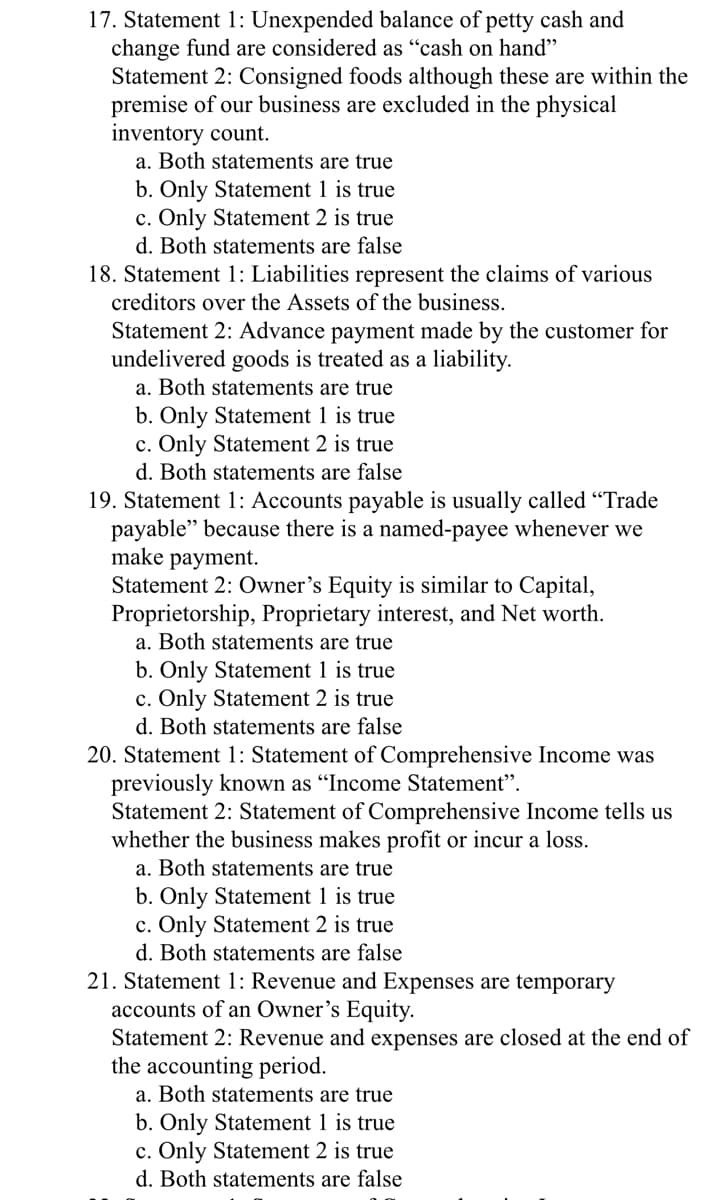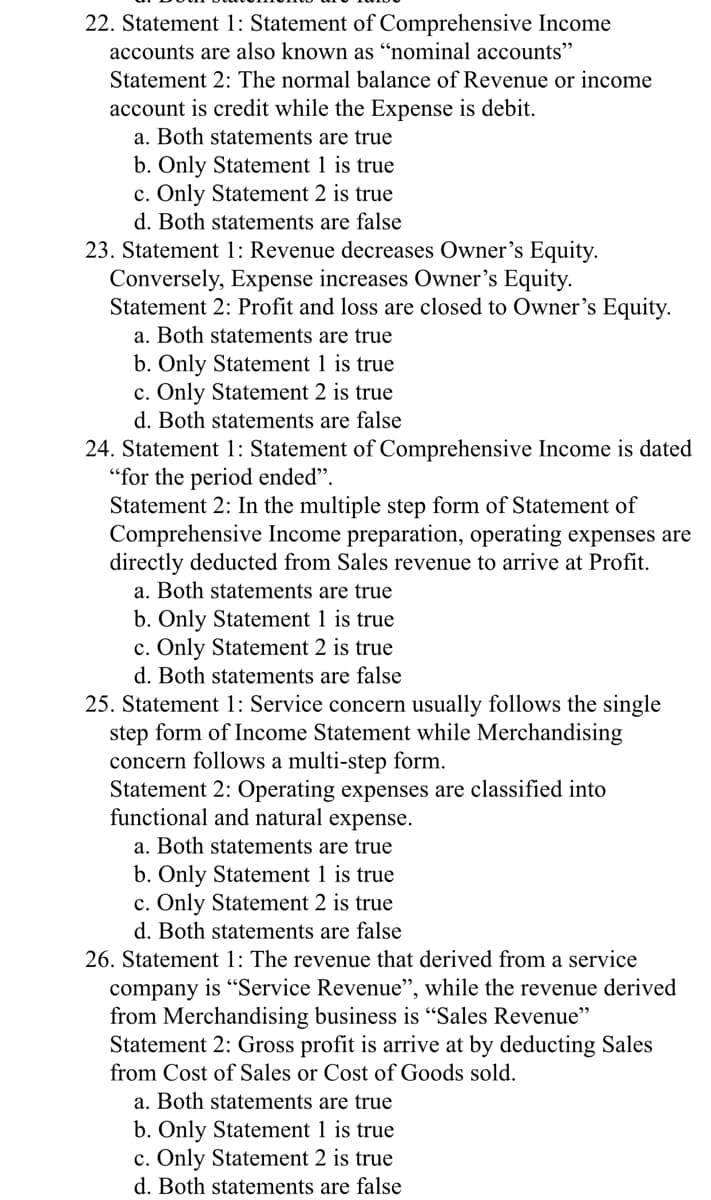17. Statement 1: Unexpended balance of petty cash and change fund are considered as "cash on hand" Statement 2: Consigned foods although these are within the premise of our business are excluded in the physical inventory count. a. Both statements are true b. Only Statement 1 is true c. Only Statement 2 is true d. Both statements are false
17. Statement 1: Unexpended balance of petty cash and change fund are considered as "cash on hand" Statement 2: Consigned foods although these are within the premise of our business are excluded in the physical inventory count. a. Both statements are true b. Only Statement 1 is true c. Only Statement 2 is true d. Both statements are false
Auditing: A Risk Based-Approach (MindTap Course List)
11th Edition
ISBN:9781337619455
Author:Karla M Johnstone, Audrey A. Gramling, Larry E. Rittenberg
Publisher:Karla M Johnstone, Audrey A. Gramling, Larry E. Rittenberg
Chapter10: Auditing Cash, Marketable Securities, And Complex Financial Instruments
Section: Chapter Questions
Problem 6RQSC
Related questions
Question

Transcribed Image Text:17. Statement 1: Unexpended balance of petty cash and
change fund are considered as "cash on hand"
Statement 2: Consigned foods although these are within the
premise of our business are excluded in the physical
inventory count.
a. Both statements are true
b. Only Statement 1 is true
c. Only Statement 2 is true
d. Both statements are false
18. Statement 1: Liabilities represent the claims of various
creditors over the Assets of the business.
Statement 2: Advance payment made by the customer for
undelivered goods is treated as a liability.
a. Both statements are true
b. Only Statement 1 is true
c. Only Statement 2 is true
d. Both statements are false
19. Statement 1: Accounts payable is usually called "Trade
payable" because there is a named-payee whenever we
make payment.
Statement 2: Owner's Equity is similar to Capital,
Proprietorship, Proprietary interest, and Net worth.
a. Both statements are true
b. Only Statement 1 is true
c. Only Statement 2 is true
d. Both statements are false
20. Statement 1: Statement of Comprehensive Income was
previously known as "Income Statement".
Statement 2: Statement of Comprehensive Income tells us
whether the business makes profit or incur a loss.
a. Both statements are true
b. Only Statement 1 is true
c. Only Statement 2 is true
d. Both statements are false
21. Statement 1: Revenue and Expenses are temporary
accounts of an Owner's Equity.
Statement 2: Revenue and expenses are closed at the end of
the accounting period.
a. Both statements are true
b. Only Statement 1 is true
c. Only Statement 2 is true
d. Both statements are false

Transcribed Image Text:22. Statement 1: Statement of Comprehensive Income
accounts are also known as “nominal accounts"
Statement 2: The normal balance of Revenue or income
account is credit while the Expense is debit.
a. Both statements are true
b. Only Statement 1 is true
c. Only Statement 2 is true
d. Both statements are false
23. Statement 1: Revenue decreases Owner's Equity.
Conversely, Expense increases Owner's Equity.
Statement 2: Profit and loss are closed to Owner's Equity.
a. Both statements are true
b. Only Statement 1 is true
c. Only Statement 2 is true
d. Both statements are false
24. Statement 1: Statement of Comprehensive Income is dated
"for the period ended".
Statement 2: In the multiple step form of Statement of
Comprehensive Income preparation, operating expenses are
directly deducted from Sales revenue to arrive at Profit.
a. Both statements are true
b. Only Statement 1 is true
c. Only Statement 2 is true
d. Both statements are false
25. Statement 1: Service concern usually follows the single
step form of Income Statement while Merchandising
concern follows a multi-step form.
Statement 2: Operating expenses are classified into
functional and natural expense.
a. Both statements are true
b. Only Statement 1 is true
c. Only Statement 2 is true
d. Both statements are false
26. Statement 1: The revenue that derived from a service
company is “Service Revenue", while the revenue derived
from Merchandising business is "Sales Revenue"
Statement 2: Gross profit is arrive at by deducting Sales
from Cost of Sales or Cost of Goods sold.
a. Both statements are true
b. Only Statement 1 is true
c. Only Statement 2 is true
d. Both statements are false
Expert Solution
This question has been solved!
Explore an expertly crafted, step-by-step solution for a thorough understanding of key concepts.
Step by step
Solved in 3 steps

Knowledge Booster
Learn more about
Need a deep-dive on the concept behind this application? Look no further. Learn more about this topic, accounting and related others by exploring similar questions and additional content below.Recommended textbooks for you

Auditing: A Risk Based-Approach (MindTap Course L…
Accounting
ISBN:
9781337619455
Author:
Karla M Johnstone, Audrey A. Gramling, Larry E. Rittenberg
Publisher:
Cengage Learning

Auditing: A Risk Based-Approach (MindTap Course L…
Accounting
ISBN:
9781337619455
Author:
Karla M Johnstone, Audrey A. Gramling, Larry E. Rittenberg
Publisher:
Cengage Learning